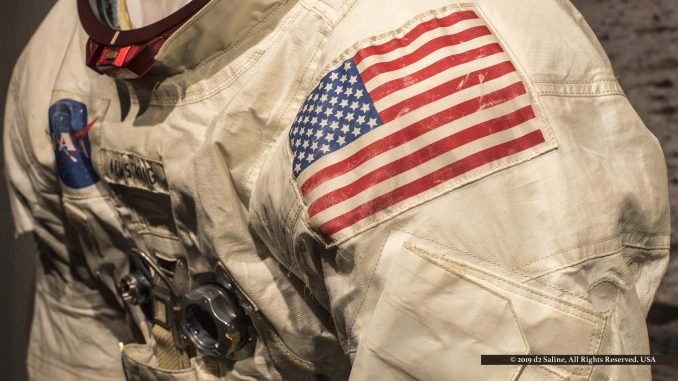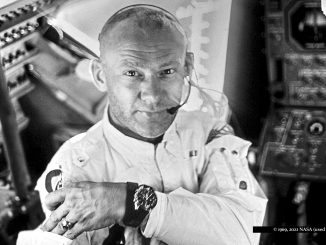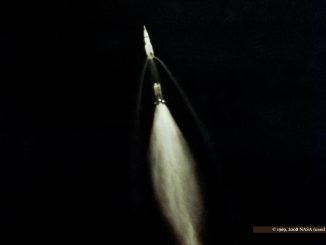
On July 16, 2019, Colonel Edwin E “Buzz” Aldrin Jr Tweeted acknowledgment to the team behind those first astronauts who set foot onto the lunar, then nearly fifty years ago. [1-3]
God bless the 400,000 Americans who helped us get to the moon and back. Together, we Americans can do anything!
Today marks the passage of exactly five decades since that historic milestone. After having entered orbit of our moon, lunar module (“LM” or “LEM”) “Eagle” separated from its docking with command module “Columbia” and began its descent to surface at 1:46pm on July 20.
According NASA mission log, at 4:05pm, Commander Neil Armstrong “throttles up the engine to slow the LM before dropping down on the lunar surface. [4-8]
The landing is not easy. The site they approach is four miles from the target point, on the southwestern edge of the Sea of Tranquility. Seeing that they are approaching a crater about the size of a football field and covered with large rocks, Armstrong takes over manual control and steers the craft to a smoother spot. His heartbeat has risen from a normal 77 to 156.
Some of the four hundred who remain top of mind. Most recall the words of US President John F Kennedy before a joint session of Congress: “I believe that this nation should commit itself to achieving the goal, before this decade is out, of landing a man on the moon ….” Many remember the names of the two astonauts referenced above, who first set foot on the moon. [9]
In a September 12, 1962 speach at Rice University, President Kennedy sought to provide understanding by putting numbers and technology needs behind the task then ahead. This ambitious one-way journey of 240,000 miles away would have at its center, “a giant rocket more than 300 feet tall …
… made of new metal alloys, some of which have not yet been invented, capable of standing heat and stresses several times more than have ever been experienced, fitted together with a precision better than the finest watch, carrying all the equipment needed for propulsion, guidance, control, communications, food and survival, on an untried mission ….
[Then] return it safely to earth, re-entering the atmosphere at speeds of over 25,000 miles per hour, causing heat about half that of the temperature of the sun … and do it right ….
Combine that with pivotal decisions that had to be right when made, and a list begins to form and lead to breaking the list of real, necessary humans behind the space program more accessible. [10]
- The “lunar-orbit rendezvous” approach was initially the subject of a protracted, divisive debate within NASA. Prevailing advocacy backed sending a single ship from Earth launch, to moon landing and departure, through splashdown in the Pacific Ocean. [11-13]
- Getting to the ultimate LEM craft design engineered by Grumman Aircraft Engineering required a severe paradigm shift from both what was expected in terms of profile and materials. Of particular note was its ascent propulsion system — completely separate from that used for descent and impossible to test prior to use. [14-18]
- Before Apollo, most computer occupied entire rooms and even floors in buildings, NASA being the first to utilize integrated circuits in creation of its onboard spacecraft guidance and navigation system counterparts. [19]
At 10:39pm, Neil Armstrong opened the Eagle hatch and began his descent down the LEM laddar, finally setting foot on the moon some seventeen minutes later. Astronaut Buzz Aldrin joined him on the lunar surface about twenty minutes later. Their moonwalk and time outside the spacecraft was over around 1:00am the following morning.
Impressive as these technical, leadership, and discipline accomplishments were, there remained a final, critical phase in completing the mission as envisioned by President John F Kennedy.
I believe that this nation should commit itself to achieving the goal, before this decade is out, of landing a man on the moon, and returning him safely to the earth.
Saline Journal is committed to putting a face on that story here next week.
References
- “Buzz Aldrin” (Edwin Eugne Aldrin Jr) Biography.
- Buzz Aldrin (Twitter feed).
- “Apollo 11” NASA.
- “Apollo 11 Moon Landing Timeline: From Liftoff to Splashdown” Dave Roos (June 24, 2019) History.
- “1969 Moon Landing” (January 30, 2019) History.
- “Neil Armstrong was the 1st man to walk on the moon 50 years ago today” ABC News (July 20, 2019) YouTube.
- “Neil Armstrong” Biography.
- “EP-72 Log of Apollo 11” NASA.
- “President Kennedy Challenges NASA to Go to the Moon” NASA Video (May 20, 2013) YouTube.
- “Moon Machines: Apollo / Lunar Module, Grumman Corporation history” Dan Beaumont Space Museum (April 29, 2017) YouTube.
- “von Braun and the lunar-orbit rendezvous decision: finding a way to go to the moon” Michael J Neufeld (2008) Acta Astronautica.
- “Meet John Houbolt: He Figured Out How To Go To The Moon, But Few Were Listening” Scott Neuman (July 18, 2019) NPR.
- “Apollo-Lunar Orbital Rendezvous Technique” NASA STI Program (April 13, 2010) YouTube.
- “Apollo News Reference: A Brief History of Grumman Aircraft Engineering Corporation” NASA.
- “To the Moon: Grumman, the company that built Apollo 11’s Lunar Module” Jason Perlow (July 17, 2019) ZD Net.
- “Apollo Lunar Module ascent propulsion – No second chance” (July 1992) Harvard University.
- “Apollo’s Ascent Engine | Make it to the Moon” Discovery Canada (July 13, 2019) YouTube.
- “What Apollo 11 pilot Michael Collins feared most during critical NASA mission” PBS NewsHour (July 17, 2019) YouTube.
- “The Real Story Behind the Apollo 11 Computer Error | WSJ” Wall Street Journal (July 15, 2019) YouTube.


